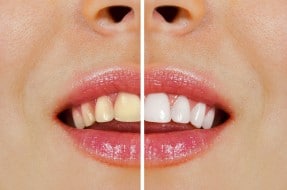Call now on0800 051 8069
How does tooth whitening work?
-
A blog discussing tooth whitening and the implications
By Ben Lees
There are a number of whitening options on the market, such as, bleaching trays, whitening toothpaste, blue-light treatment, gels or varnishes. However, do we know how these methods really work and whether there are any risks involved in using them?
Many patients would probably say they trust anything sold by their dentist, or a reputable shop. Many would assume it is fine to use and so they do not need to know how it works and just need to know that it will work.
It is important that patients are aware of the mechanics of tooth whitening because they need to know what to expect in terms of possible side effects and what results will be achieved.
The main component of tooth whitening
In the UK all tooth whitening home kits must contain only 1% hydrogen peroxide and all whitening treatments offered by dentists must contain equal to or less than 6%. Hydrogen peroxide will bleach the stains on the surface of the enamel of the tooth and this is why teeth become whiter. It is therefore the most important component in teeth whitening products. However, what many people do not realise is that it will only restore the teeth to their natural whiteness and it is not certain that the teeth will appear a shade lighter.
Tooth whitening does not continue to whiten the tooth to the point that it achieves the ever-popular bright, white Hollywood smile, unless the teeth were that colour before any staining had occurred. Unfortunately, many people see the likes of Towie stars, Jess Wright and Frankie Essex, and want to achieve the white smiles they have. Most famous for her pearly gnashers is Chloe Sims, and more and more people want to achieve that ‘Matt White’ smile, previously only achieved by Dulux painted walls.
So, the bombshell I must drop is that most of the photographs you see of these teeth are usually as a result of the following and not necessarily as a consequence of a whitening product:
– Photoshop! It is true, I even have an app on my phone to whiten my teeth;
– The ability to match the perfect shade of red lipstick to set-off white teeth;
– Crowns
– Veneers
Veneers are the most popular choice because veneers can also achieve uniformity, and lengthening, as well as whitening. Veneers involve the shaving off of a layer of enamel on the tooth to then replace with a veneer casing and this does slightly weaken the tooth. More serious problems can occur if veneers crack and require frequent replacement.
In such a scenario, slowly but surely, more and more tiny layers of enamel are shaved off to prepare the teeth for a veneer and therefore, there is a risk that eventually the enamel of the tooth would run out and the tooth itself might need replacement. Crown placement carries similar risks, however, crowns are usually a cosmetic end to a necessary restorative procedure (such as, root canal treatment).
The most important thing to remember is, out of the options above, tooth whitening products are only able to achieve a lighter shade for your teeth by eradicating stains and will not necessarily achieve that “Daz” whiter than white look.
It is therefore, essential to seek your dentist’s advice on what you can achieve and what possible side effects there are. Try to seek out a specialist registered on the General Dental Council’s register and make sure you are confident in what your dentist is recommending because we sadly, have a number of Clients who have had cosmetic treatment which was wholly inappropriate and, in some cases, significantly damaging.







